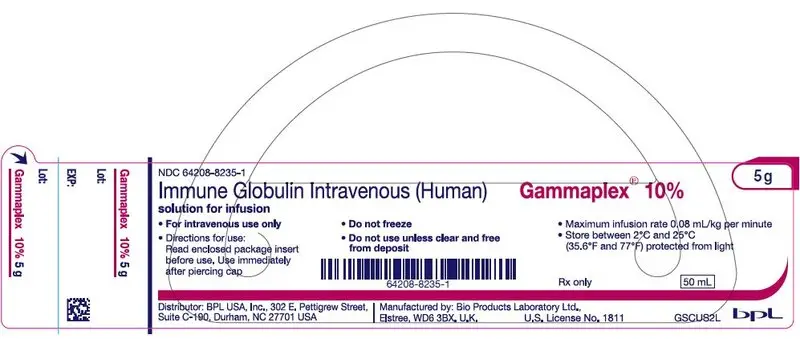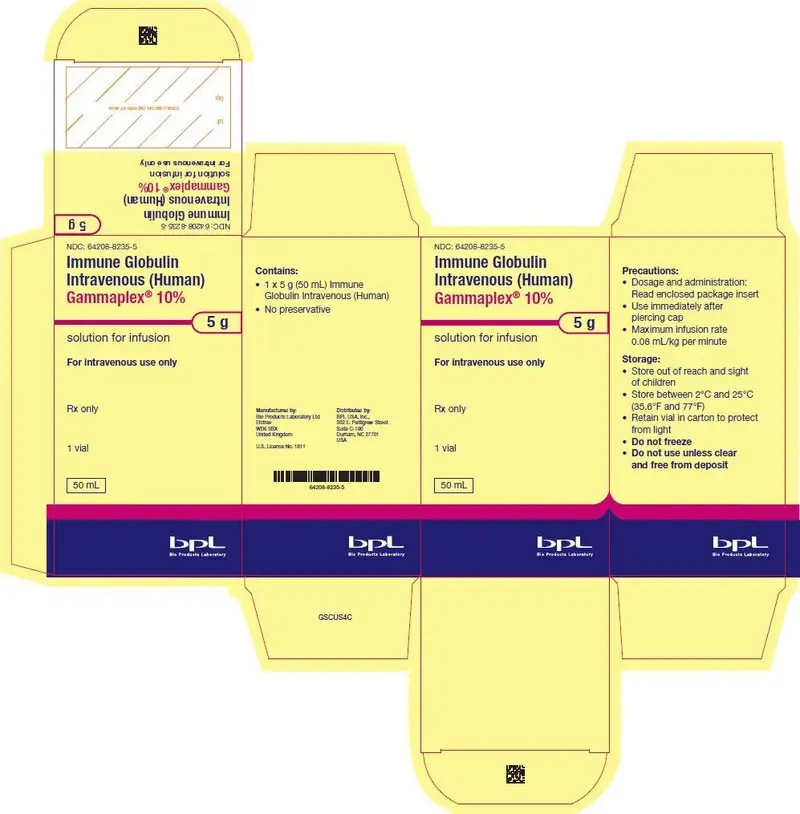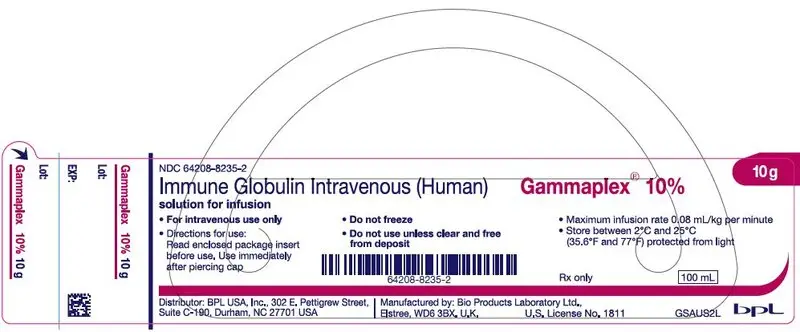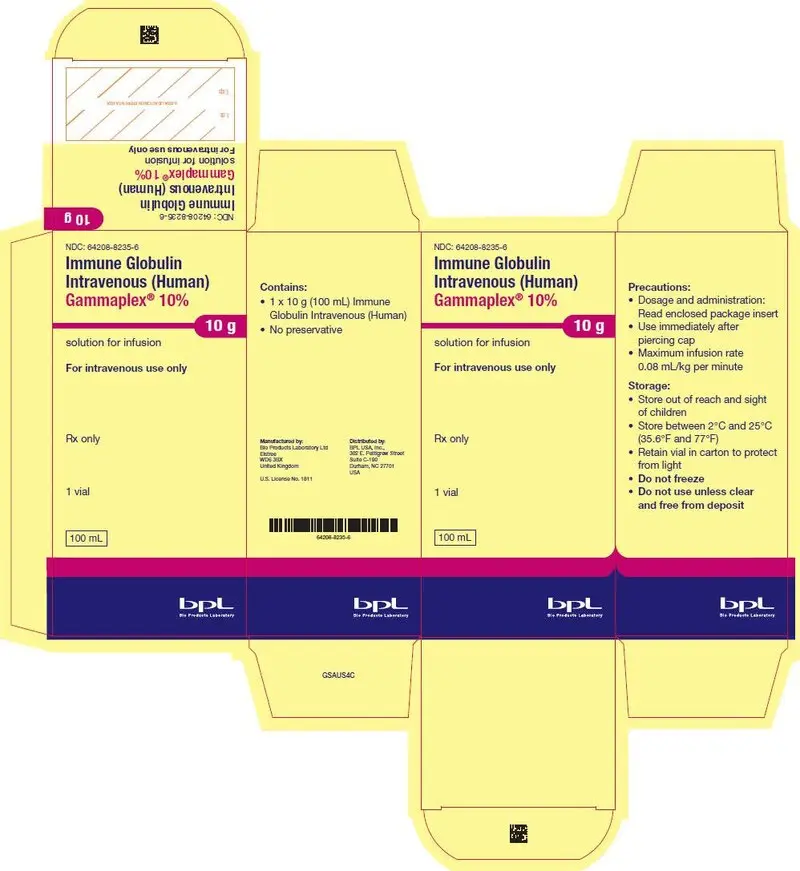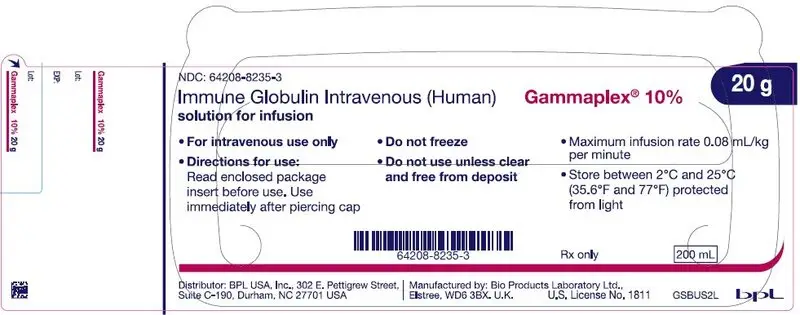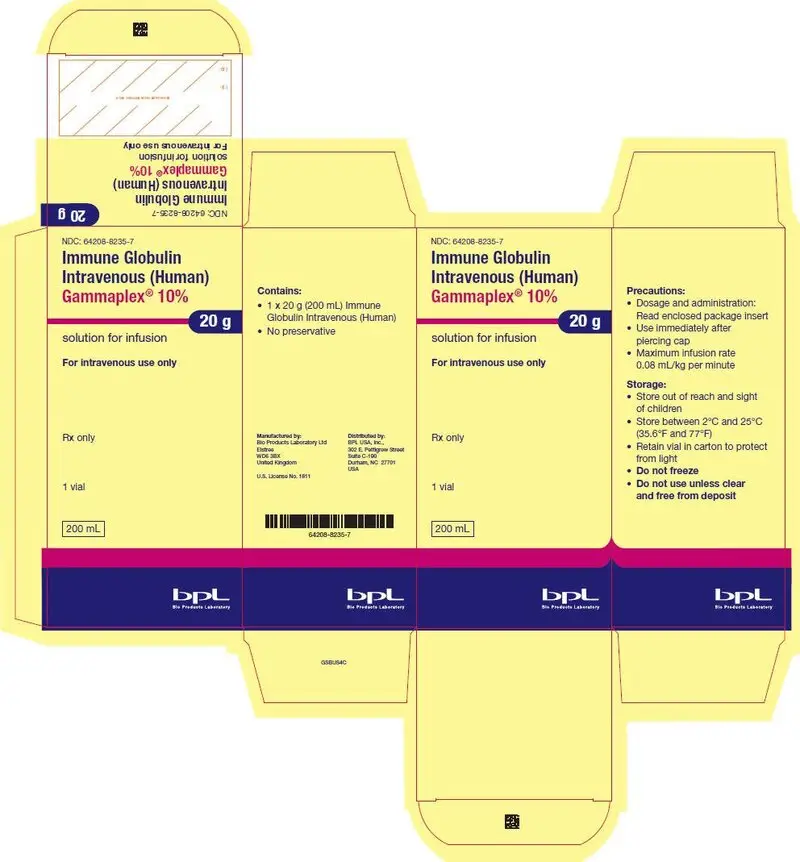Drug Detail:Gammaplex (igiv) (Immune globulin (igiv) (intravenous) [ im-myoon-glob-yoo-lin ])
Drug Class: Immune globulins
Highlights of Prescribing Information
GAMMAPLEX 10% Immune Globulin Intravenous [Human], 10% Liquid
Initial U.S. Approval: 2017
WARNING: THROMBOSIS, RENAL DYSFUNCTION and ACUTE RENAL FAILURE
See full prescribing information for complete boxed warning.
- Thrombosis may occur with immune globulin products, including GAMMAPLEX 10%. Risk factors may include: advanced age, prolonged immobilization, hypercoagulable conditions, history of venous or arterial thrombosis, use of estrogens, indwelling vascular catheters, hyperviscosity and cardiovascular risk factors (5.2)
- Renal dysfunction, acute renal failure, osmotic nephrosis, and death1 may occur in predisposed patients with immune globulin intravenous (lGIV) products, including GAMMAPLEX 10%
- Renal dysfunction and acute renal failure occur more commonly with IGIV products containing sucrose. GAMMAPLEX 10% does not contain sucrose (5.1)
- For patients at risk of thrombosis, renal dysfunction or acute renal failure, administer GAMMAPLEX 10% at the minimum dose and infusion rate practicable. Ensure adequate hydration in patients before administration. Monitor for signs and symptoms of thrombosis and assess blood viscosity in patients at risk for hyperviscosity (2.3, 5.2)
Indications and Usage for Gammaplex
GAMMAPLEX 10% is an Immune Globulin Intravenous (Human) 10% Liquid indicated for the treatment of:
- primary humoral immunodeficiency (PI) in adults and pediatric patients 2 years of age and older (1.1)
- chronic immune thrombocytopenic purpura (ITP) in adults (1.2)
Gammaplex Dosage and Administration
For Intravenous Use Only
| Indication | Dose | Initial infusion rate | Maintenance infusion rate (if tolerated) |
|---|---|---|---|
| PI | 300-800 mg/kg (3-8 mL/kg) every 3-4 weeks | 0.5 mg/kg/min (0.005 mL/kg/min) for 15 minutes | Increase gradually every 15 minutes to 8 mg/kg/min (0.08 mL/kg/min) |
| ITP | 1 g/kg (10 mL/kg) for 2 consecutive days | 0.5 mg/kg/min (0.005 mL/kg/min) for 15 minutes | Increase gradually every 15 minutes to 8 mg/kg/min (0.08 mL/kg/min) |
- Ensure that patients with pre-existing renal insufficiency are not volume depleted; discontinue GAMMAPLEX 10% if renal function deteriorates (2.3, 5.1)
- For patients at risk of renal dysfunction, thrombotic events or volume overload, administer GAMMAPLEX 10% at the minimum infusion rate practicable (2.3, 5.1, 5.2, 5.8)
Dosage Forms and Strengths
GAMMAPLEX 10% is a liquid solution containing 10% IgG (100 mg/mL). (3)
Contraindications
- History of anaphylactic or severe systemic reactions to human immunoglobulin (4)
- IgA-deficient patients with antibodies against IgA and a history of hypersensitivity (4)
Warnings and Precautions
- IgA-deficient patients with antibodies to IgA are at greater risk of developing severe hypersensitivity and anaphylactic reactions (5.3)
- Hyperproteinemia, increased serum viscosity, and hyponatremia may occur in patients receiving IGIV therapy (5.4)
- Aseptic meningitis syndrome may occur, especially with high doses or rapid infusion (5.5)
- Hemolysis, either intravascular or due to enhanced red blood cell sequestration, can develop subsequent to GAMMAPLEX 10% treatments. Risk factors include high doses and non-O blood group. Closely monitor patients for hemolysis and hemolytic anemia (5.6)
- Monitor patients for pulmonary adverse reactions (transfusion-related acute lung injury [TRALI]) (5.7)
- Volume overload can occur. Monitor for signs and symptoms (5.8)
- Consider risks and benefits before prescribing the high dose regimen for chronic ITP in patients at risk of thrombosis, hemolysis, acute kidney injury, or volume overload (5)
- GAMMAPLEX 10% is made from human plasma and may contain infectious agents, e.g. viruses and, theoretically, the Creutzfeldt-Jakob disease agent (5.9)
- Passive transfer of antibodies may confound serologic testing (5.10)
Adverse Reactions/Side Effects
- PI - The most common adverse reactions reported in ≥5% of clinical trial subjects were headache, migraine and pyrexia (6)
- Chronic ITP - The safety of GAMMAPLEX 10% has not been established in patients with ITP. However, the safety of GAMMAPLEX 5% has been studied in subjects with ITP, and it is anticipated that the safety profile for both formulations are comparable for ITP patients. Hence adverse reaction information is presented for GAMMAPLEX 5% where relevant. The most common adverse reactions reported with GAMMAPLEX 5% in ≥5% of clinical trial subjects with ITP were headache, vomiting, pyrexia, nausea, arthralgia and dehydration (6)
To report SUSPECTED ADVERSE REACTIONS, contact BPL Inc. (1-844-427-5872) or [email protected], FDA (1-800-FDA-1088) or www.fda.gov/medwatch
Drug Interactions
- Passive transfer of antibodies may transiently interfere with the immune response to live virus vaccines, e.g. measles, mumps, and rubella (7)
- Therapy with GAMMAPLEX 10% may confound serological testing (7)
Use In Specific Populations
- Pediatrics: In pediatric patients 2 years of age and older, the pharmacokinetics, dosage and safety are similar to those in adults (8.4)
- Geriatrics: In patients over the age of 65 years or in any patient at risk of developing renal insufficiency, do not exceed the recommended dose and infuse GAMMAPLEX 10% at the minimum rate practicable (8.5)
See 17 for PATIENT COUNSELING INFORMATION.
Revised: 11/2021
Related/similar drugs
Nplate, Promacta, Tavalisse, Doptelet, WinRho SDF, prednisone, dexamethasoneFull Prescribing Information
WARNING: THROMBOSIS, RENAL DYSFUNCTION and ACUTE RENAL FAILURE
- Thrombosis may occur with immune globulin products, including GAMMAPLEX 10%. Risk factors may include: advanced age, prolonged immobilization, hypercoagulable conditions, history of venous or arterial thrombosis, use of estrogens, indwelling central vascular catheters, hyperviscosity and cardiovascular risk factors. Thrombosis may occur in the absence of known risk factors [see Warnings and Precautions (5.2), Patient Counseling Information (17)].
- Renal dysfunction, acute renal failure, osmotic nephrosis, and death1 may occur in predisposed patients who receive immune globulin intravenous (lGIV) products.
- Patients predisposed to renal dysfunction include those with any degree of pre-existing renal insufficiency, diabetes mellitus, age greater than 65 years, volume depletion, sepsis, paraproteinemia, or patients receiving known nephrotoxic drugs [see Warnings and Precautions (5.1)]. Renal dysfunction and acute renal failure occur more commonly in patients receiving IGIV products containing sucrose. GAMMAPLEX 10% does not contain sucrose.
- For patients at risk of thrombosis, renal dysfunction or acute renal failure, administer GAMMAPLEX 10% at the minimum dose and infusion rate practicable. Ensure adequate hydration in patients before administration. Monitor for signs and symptoms of thrombosis and assess blood viscosity in patients at risk for hyperviscosity [see Dosage and Administration (2.1, 2.3), Warnings and Precautions (5.2)].
1. Indications and Usage for Gammaplex
1.1 Primary Humoral Immunodeficiency (PI)
GAMMAPLEX 10% is an Immune Globulin Intravenous (Human), 10% Liquid indicated for replacement therapy in primary humoral immunodeficiency (PI) in adults and pediatric patients 2 years of age and older. This includes, but is not limited to, the humoral immune defect in common variable immunodeficiency, X-linked agammaglobulinemia, congenital agammaglobulinemia, Wiskott-Aldrich syndrome, and severe combined immunodeficiencies.
2. Gammaplex Dosage and Administration
For Intravenous Use Only
2.1 Dosage
| Indication | Dose | Initial infusion rate | Maintenance infusion rate (if tolerated) |
|---|---|---|---|
| PI | 300-800 mg/kg (3-8 mL/kg) every 3-4 weeks | 0.5 mg/kg/min (0.005 mL/kg/min) for 15 minutes | Increase gradually every 15 minutes to 8 mg/kg/min (0.08 mL/kg/min) |
| ITP | 1 g/kg (10 mL/kg) for 2 consecutive days | 0.5 mg/kg/min (0.005 mL/kg/min) for 15 minutes | Increase gradually every 15 minutes to 8 mg/kg/min (0.08 mL/kg/min) |
2.2 Preparation and Handling
- GAMMAPLEX 10% is a clear or slightly opalescent, colorless or pale yellow liquid. Visually inspect parenteral drug products for particulate matter and discoloration prior to administration whenever solution and container permit. Do not use if the solution is cloudy or turbid, or if it contains particulate matter
- GAMMAPLEX 10% vials are for single use only. Dispose of partially used or unused product
- GAMMAPLEX 10% contains no antimicrobial preservatives. Therefore, prompt administration after preparation is necessary
- Do not shake
- Administer GAMMAPLEX 10% at room temperature (up to 25°C [77°F])
- Do not use any solution that has been frozen [see How Supplied/ Storage and Handling (16)]
- Infuse GAMMAPLEX 10% using a separate infusion line
- Do not mix GAMMAPLEX 10% with other intravenous medications (including normal saline) or other IGIV products
- An infusion pump may be used to control the rate of administration
- For administration of large doses, pool multiple vials using aseptic technique
2.3 Administration
- Hydrate the patient adequately prior to the initiation of infusion
- Infuse GAMMAPLEX 10% intravenously using an intravenous infusion set. See Table 1 for recommended infusion rates
- Monitor vital signs throughout the infusion
- Slow or stop the infusion if adverse reactions occur
- If symptoms subside, the infusion may be resumed at a lower rate that is comfortable for the patient
- The observation time of patients after GAMMAPLEX 10% administration may vary. If the patient (a) has not received GAMMAPLEX 10% or another IgG product, (b) is switched from an alternative IGIV product or (c) has had a long interval since the previous infusion, prolong the observation time for adverse reactions after GAMMAPLEX 10% infusion
- Certain severe adverse reactions may be related to the rate of infusion. Slowing or stopping the infusion often allows the reaction to disappear
- Close monitoring of the infusion rate in pediatric patients is recommended
- Ensure that patients with pre-existing renal insufficiency are not volume depleted
- For patients at increased risk of renal dysfunction, thrombotic events, or volume overload, administer GAMMAPLEX 10% at the minimum infusion rate practicable. Consider discontinuing GAMMAPLEX 10% administration if renal function deteriorates [see Boxed Warning, Warnings and Precautions (5.1, 5.2, 5.8)]
4. Contraindications
- GAMMAPLEX 10% is contraindicated in patients who have had an anaphylactic or severe systemic reaction to the administration of human immune globulin
- GAMMAPLEX 10% is contraindicated in IgA-deficient patients with antibodies to IgA and a history of hypersensitivity
5. Warnings and Precautions
5.1 Renal Dysfunction/Failure
Acute renal dysfunction/failure, osmotic nephropathy, and death1 may occur upon use of human IGIV products. Ensure that patients are not volume depleted before administering GAMMAPLEX 10%. In patients who are at risk of developing renal dysfunction, because of pre-existing renal insufficiency, predisposition to acute renal failure (such as diabetes mellitus, hypovolemia, overweight, use of concomitant nephrotoxic medicinal products or age >65 years), administer GAMMAPLEX 10% at the minimum infusion rate practicable [see Dosage and Administration (2.3)].
Periodic monitoring of renal function and urine output is particularly important in patients judged to be at increased risk of developing acute renal failure. Assess renal function, including measurement of blood urea nitrogen (BUN) and serum creatinine, before the initial infusion of GAMMAPLEX 10% and at appropriate intervals thereafter. If renal function deteriorates, consider discontinuing GAMMAPLEX 10%.
5.2 Thrombotic Events
Thrombosis may occur following treatment with immune globulin products, including GAMMAPLEX 10%2. Risk factors may include: advanced age, prolonged immobilization, hypercoagulable conditions, history of venous or arterial thrombosis, use of estrogens, indwelling central vascular catheters, hyperviscosity and cardiovascular risk factors. Thrombosis may occur in the absence of known risk factors.
Consider baseline assessment of blood viscosity in patients at risk for hyperviscosity, including those with cryoglobulins, fasting chylomicronemia/markedly high triacylglycerols (triglycerides), or monoclonal gammopathies. For patients at risk of thrombosis, administer GAMMAPLEX 10% at the minimum dose and infusion rate practicable. Ensure adequate hydration in patients before administration. Monitor for signs and symptoms of thrombosis and assess blood viscosity in patients at risk for hyperviscosity [see Boxed Warning, Dosage and Administration (2.3), Patient Counseling Information (17)].
5.3 Hypersensitivity
Severe hypersensitivity reactions may occur [see Contraindications (4)]. In case of hypersensitivity, discontinue GAMMAPLEX 10% infusion immediately and institute appropriate treatment. Medications such as epinephrine should be available for immediate treatment of acute hypersensitivity reactions.
GAMMAPLEX 10% contains trace amounts of IgA (<20 micrograms/mL) [see Description (11)]. Patients with known antibodies to IgA may have a greater risk of developing potentially severe hypersensitivity and anaphylactic reactions. GAMMAPLEX 10% is contraindicated in patients with antibodies against IgA and a history of hypersensitivity reaction [see Contraindications (4)].
5.4 Hyperproteinemia, Increased Serum Viscosity, and Hyponatremia
Hyperproteinemia, increased serum viscosity, and hyponatremia may occur in patients receiving IGIV therapy. It is critical to clinically distinguish true hyponatremia from a pseudohyponatremia that is associated with or causally related to hyperproteinemia with concomitant decreased calculated serum osmolality or elevated osmolar gap, because treatment aimed at decreasing serum free water in patients with pseudohyponatremia may lead to volume depletion, a further increase in serum viscosity, and a possible predisposition to thrombotic events2.
5.5 Aseptic Meningitis Syndrome (AMS)
AMS may occur with IGIV treatment. AMS usually begins within several hours to 2 days following IGIV treatment. Discontinuation of IGIV treatment has resulted in remission of AMS within several days without sequelae3.
AMS is characterized by the following signs and symptoms: severe headache, nuchal rigidity, drowsiness, fever, photophobia, painful eye movements, nausea, and vomiting [see Patient Counseling Information (17)]. Cerebrospinal fluid (CSF) studies frequently reveal pleocytosis up to several thousand cells per cubic millimeter, predominantly from the granulocytic series, and elevated protein levels up to several hundred mg/dL, but negative culture results. Conduct a thorough neurological examination on patients exhibiting such signs and symptoms, including CSF studies, to rule out other causes of meningitis. AMS may occur more frequently in association with high doses (2 g/kg) and/or rapid infusion of IGIV.
5.6 Hemolysis
GAMMAPLEX 10% may contain blood group antibodies that can act as hemolysins and induce in vivo coating of red blood cells (RBCs) with immunoglobulin, causing a positive direct antiglobulin test (DAT) (Coombs' test) result and hemolysis4. Delayed hemolytic anemia can develop subsequent to IGIV therapy due to enhanced RBC sequestration; acute hemolysis, consistent with intravascular hemolysis, has been reported5. Cases of severe hemolysis-related renal dysfunction/failure or disseminated intravascular coagulation have occurred following infusion of IGIV.
The following risk factors may be associated with the development of hemolysis following IGIV administration: high doses (e.g. ≥2 g/kg), given either as a single administration or divided over several days, and non-O blood group6. Other individual patient factors, such as an underlying inflammatory state (as may be reflected by, for example, elevated C-reactive protein or erythrocyte sedimentation rate), have been hypothesized to increase the risk of hemolysis following administration of IGIV7, but their role is uncertain. Hemolysis has been reported following administration of IGIV for a variety of indications, including ITP and PI4.
Closely monitor patients for clinical signs and symptoms of hemolysis, particularly patients with risk factors noted above. Consider appropriate laboratory testing in higher risk patients, including measurement of hemoglobin or hematocrit prior to infusion and within approximately 36 to 96 hours post infusion. If clinical signs and symptoms of hemolysis or a significant drop in hemoglobin or hematocrit have been observed, perform confirmatory laboratory testing. If transfusion is indicated for patients who develop hemolysis with clinically compromising anemia after receiving IGIV, perform adequate cross-matching to avoid exacerbating on-going hemolysis.
5.7 Transfusion-related Acute Lung Injury (TRALI)
Noncardiogenic pulmonary edema may occur in patients following IGIV treatment8. TRALI is characterized by severe respiratory distress, pulmonary edema, hypoxemia, normal left ventricular function and fever. Symptoms typically appear within 1 to 6 hours following treatment.
Monitor patients for pulmonary adverse reactions. If TRALI is suspected, perform appropriate tests for the presence of anti-neutrophil antibodies in both the product and the patient's serum.
TRALI may be managed using oxygen therapy with adequate ventilatory support.
5.8 Volume Overload
Carefully consider the relative risks and benefits before prescribing the high dose regimen (for chronic ITP) in patients at increased risk of volume overload.
5.9 Transmissible Infectious Agents
As GAMMAPLEX 10% is made from human blood, it may carry a risk of transmitting infectious agents, e.g. viruses, the variant Creutzfeldt-Jakob disease (vCJD) agent and, theoretically, the Creutzfeldt-Jakob disease (CJD) agent. No cases of transmission of viral diseases or CJD have been associated with the use of GAMMAPLEX 10%. All infections suspected by a physician possibly to have been transmitted by this product should be reported by the physician or other healthcare providers to BPL Inc. 1-844-427-5872 or [email protected].
Before prescribing GAMMAPLEX 10%, the physician should discuss the risks and benefits of its use with the patient [see Patient Counseling Information (17)].
5.10 Laboratory Tests
- After infusion of immunoglobulin, the transitory rise of the various passively transferred antibodies in the patient's blood may yield positive serological testing results, with the potential for misleading interpretation
- Passive transmission of antibodies to erythrocyte antigens (e.g. A, B, and D) may cause a positive direct or indirect antiglobulin (Coombs') test
- Clinically assess patients with known renal dysfunction, diabetes mellitus, age greater than 65 years, volume depletion, sepsis, paraproteinemia, or those receiving nephrotoxic agents, and monitor as appropriate (BUN, serum creatinine, urine output) during therapy with GAMMAPLEX 10%
- Consider baseline assessment of blood viscosity in patients at risk for hyperviscosity, including those with polycythemia, cryoglobulins, fasting chylomicronemia/markedly high triglycerides, or monoclonal gammopathies
- Consider measuring hemoglobin or hematocrit at baseline and approximately 36 to 96 hours post infusion in patients at higher risk of hemolysis. If signs and/or symptoms of hemolysis are present after an infusion of GAMMAPLEX 10%, perform appropriate laboratory testing for confirmation
- If TRALI is suspected, perform appropriate tests for the presence of anti-neutrophil antibodies in both the product and patient's serum
6. Adverse Reactions/Side Effects
The safety information for GAMMAPLEX 10% is based on the clinical trial evaluating the bioequivalence of GAMMAPLEX 10% to GAMMAPLEX 5% in subjects with PI. The safety of GAMMAPLEX 10% has not been established in patients with ITP. However, the safety profile for GAMMAPLEX 5% has been studied in subjects with ITP, and it is anticipated that the safety profile for both formulations are comparable for ITP patients. Hence adverse reaction (AR) information is presented for GAMMAPLEX 5% where relevant. ARs are adverse events that were deemed by the investigators as causally related to GAMMAPLEX 10%.
There were no serious ARs observed with GAMMAPLEX 10% in the clinical trial in adult or pediatric subjects with PI.
Serious ARs observed with GAMMAPLEX 5% in clinical trial subjects with ITP were headache, vomiting and dehydration. In addition, following a review of the data, 4 subjects (11%) were considered to have experienced asymptomatic suspected treatment-emergent hemolysis [see Clinical Trials Experience (6.1)].
The following potential serious ARs are described above and/or elsewhere in the labeling:
- Thrombotic Events [see Warnings and Precautions (5.2)]
- Hemolysis [see Warnings and Precautions (5.6)]
The most common ARs occurring in ≥5% of adult subjects receiving GAMMAPLEX 10% in the PI clinical trial were headache (4 subjects, 12.5%), migraine (2 subjects, 6.3%) and pyrexia (2 subjects, 6.3%) and for pediatric subjects 3 years of age and older, in the same study, headache (3 subjects, 20.0%); other ARs occurred in a single pediatric subject. Overall, ARs which occurred in ≥5% of the adult and pediatric subjects combined are shown in Table 2.
The most common ARs occurring in ≥5% of adult subjects receiving GAMMAPLEX 5% in the chronic ITP clinical trial were headache (10 subjects, 28.6%), vomiting (6 subjects, 17.1%), pyrexia (5 subjects, 14.3%), nausea (3 subjects, 8.6%), arthralgia (2 subjects, 5.7%) and dehydration (2 subjects, 5.7%).
6.1 Clinical Trials Experience
Because clinical trials are conducted under widely varying conditions, adverse reaction rates observed in the clinical trials of a drug cannot be directly compared to rates in the clinical trials of another drug and may not reflect the rates observed in clinical practice.
7. Drug Interactions
- Transitory rise of the various passively transferred antibodies in the patient's blood after infusion of immunoglobulin may yield positive serological testing results, with the potential for misleading interpretation. Passive transmission of antibodies to erythrocyte antigens (e.g. A, B, and D) may cause a positive direct or indirect antiglobulin (Coombs') test.
- Passive transfer of antibodies may transiently interfere with the immune response to live virus vaccines such as measles, mumps, rubella and varicella.10, 11
Inform the immunizing physician of recent therapy with GAMMAPLEX 10% so that appropriate measures may be taken [see Patient Counseling Information (17)].
8. Use In Specific Populations
8.4 Pediatric Use
In pediatric subjects 3 years of age and older, the pharmacokinetics, dosage and safety are similar to those in adults.
8.5 Geriatric Use
Use caution when administering GAMMAPLEX 10% to patients aged 65 years and over who are judged to be at increased risk of developing renal insufficiency or thrombotic events [see Boxed Warning, Warnings and Precautions (5.1, 5.2)]. Do not exceed recommended doses, and administer GAMMAPLEX 10% at the minimum infusion rate practicable.
No subjects over the age of 55 years were included in the clinical study of GAMMAPLEX 10%. Eight (8) patients with PI at or over the age of 65 years were included within the clinical evaluation of GAMMAPLEX 5%. The number of geriatric patients was too small for separate evaluation from the younger patients for safety or efficacy [see Clinical Studies (14)].
10. Overdosage
Overdosage may lead to fluid overload and hyperviscosity, particularly in the elderly and in patients with renal impairment.
11. Gammaplex Description
GAMMAPLEX 10% is a ready to use sterile solution of polyclonal human Immunoglobulin G for intravenous administration that contains glycine and polysorbate 80 as stabilizers. Specifically, GAMMAPLEX 10% contains approximately 10 g normal human immunoglobulin and 200-300 mM glycine in 100 mL of buffer solution containing: <30 mM acetate, <30 mM sodium chloride and 1-6 mg polysorbate 80. Immunoglobulin G purity is ≥98%, the pH is in the range of 4.9 to 5.3, and osmolality is not less than 240 mOsmol/kg (typically 280 mOsmol/kg). The distribution of the four IgG subclasses reflects that of normal plasma. The content of IgA is less than 20 micrograms/mL. The anti-D and anti-A/anti-B hemagglutinin content of the drug product is strictly controlled to specification.
GAMMAPLEX 10% contains no reducing carbohydrate stabilizers (e.g. sucrose, maltose) and no preservative.
GAMMAPLEX 10% is prepared from large pools of human plasma by a combination of cold ethanol fractionation and ion exchange chromatography. Fab functions tested include antigen binding activity, and Fc functions tested include complement activation and rubella antibody-mediated hemolysis.
GAMMAPLEX 10% is manufactured from plasma, obtained from healthy US donors, who have passed viral screening tests. All donors are subjected to medical examinations, laboratory tests, and a review of their medical history before being allowed to donate blood or plasma.
All plasma donations are screened for antibody to HIV-1/2 and hepatitis C virus (HCV), and hepatitis B surface antigen (HBsAg). Additional testing of donations is carried out in plasma mini-pools (512 donations per pool) that undergo nucleic acid amplification testing (NAT) for HIV, hepatitis B virus (HBV), HCV, hepatitis A virus (HAV) and parvovirus B19.
Further testing is carried out on the manufacturing pools for HBsAg, and antibody to HIV-1/2; HCV and parvovirus B19 are also tested by NAT, with the limit for B19 set to not exceed 104 IU B19 DNA per mL plasma.
There are three processing steps specifically designed to remove or inactivate viruses:
1) Solvent/Detergent treatment is targeted to enveloped viruses;
2) A virus filtration step designed to remove small viruses including non-enveloped viruses, on a size exclusion basis; and
3) The terminal low pH incubation step is identified as contributing to the overall viral clearance capacity for enveloped and non-enveloped viruses.
The capacity of the manufacturing process to remove and/or inactivate enveloped and non-enveloped viruses has been validated by laboratory spiking studies on a scaled down process model. Overall virus reduction was calculated only from steps that were mechanistically independent from each other.
In addition, each step was validated to provide robust virus reduction. Table 5 presents the contribution of each process step to virus reduction and the overall process reduction.
| Virus | Type (Envelope/Genome) | Size (nm) | Process Log10 Reduction of Virus (LRV) over manufacturing step | |||
|---|---|---|---|---|---|---|
| Solvent Detergent | 20 nm filtration | Terminal low pH/elevated temperature incubation | Total LRV | |||
| HIV: Human immunodeficiency virus | ||||||
| SIN: Sindbis virus, model for hepatitis C virus (HCV) | ||||||
| WNV: West Nile Virus | ||||||
| BVDV: Bovine viral diarrhea virus, model for HCV | ||||||
| IBR: Infectious bovine rhinotracheitis, bovine herpes virus model for enveloped DNA viruses including hepatitis B | ||||||
| HAV: Hepatitis A virus | ||||||
| EMC: Encephalomyocarditis, model for HAV | ||||||
| CPV: Canine parvovirus, model for human parvovirus B19 | ||||||
| NA: Not applicable, solvent detergent step is limited to the inactivation of enveloped viruses | ||||||
| I: Inactivation by the product intermediate precluded the accurate estimation of the removal of these viruses by the filtration step | ||||||
| NT: Not tested | ||||||
| B19: Viral clearance of human parvovirus B19 was investigated experimentally at the 20 nm filtration step. The estimated Log reduction Factor obtained was 6.0 | ||||||
| HIV | Env/RNA | 80-100 | >6.8 | I | >6.0 | >12.8 |
| SIN | Env/RNA | 70 | >6.7 | 6.2 | >6.8 | >19.7 |
| WNV | Env/RNA | 50 | >6.4 | I | NT | >6.4 |
| BVDV | Env/RNA | 40-60 | >5.6 | I | >4.6 | >10.2 |
| IBR | Env/DNA | 200 | >5.0 | I | >5.4 | >10.4 |
| HAV | Non-Env/RNA | 30 | NA | >4.8 | 1.3 | >6.1 |
| EMC | Non-Env/RNA | 30 | NA | >4.8 | 3.4 | >8.2 |
| CPV | Non-Env/RNA | 18-24 | NA | 3.2 | 1.0 | 4.2 |
14. Clinical Studies
14.2 Treatment of Chronic Immune Thrombocytopenic Purpura
The crossover bioequivalence study described in 14.1, above, did not include subjects with ITP. The results of the bioequivalence study comparing GAMMAPLEX 10% to GAMMAPLEX 5% in subjects with PI are supportive of the potential effectiveness of GAMMAPLEX 10% in the treatment of chronic ITP.
In a Phase 3 multicenter, open-label clinical trial to evaluate the efficacy and safety of GAMMAPLEX 5% in chronic ITP, of the 35 subjects enrolled from various ethnic groups, 9 were male and 26 were female. The age range was between 6 and 69 years. Subjects received intravenous infusions on two consecutive days (1 course) and then observed for a further 30 days. Individuals were given the option of a further two courses of treatment (if required), where only safety variables were assessed. Doses of GAMMAPLEX 5% ranged from 482 to 1149 mg/kg on Day 1 and Day 2. The median total dose per subject was 2035 mg/kg. Subjects received a total of 94 infusions (48 treatment courses).
All 35 subjects received at least one infusion of clinical trial drug, and all but one subject completed the first course of treatment.
The primary analysis was based on the platelet count achieved by Day 9 after the first course of treatment with GAMMAPLEX 5%, response being defined as a platelet count of 50 × 109/L or greater. Response to treatment on or before Day 9 was achieved by 29 of 35 subjects (82.9%), and the one-sided 97.5% lower confidence limit of the response rate was 66.4%, which met the a priori success criterion that required it to be greater than 60%.
Efficacy analyses included the duration of response, and changes in the incidences of bleeding or hemorrhage. At Day 32, the median (+ SD) platelet count (24 + [90] × 109/L) was still higher than the baseline value, and 11 of 33 subjects (33.3%) continued to show response of platelet counts of 50 × 109/L or greater. The median duration of platelet count response for the responders was 10 days.
| Number of days in clinical trial | Day 1 | Day 2 | Day 3 | Day 5 | Day 9 | Day 14 | Day 21 | Day 32 |
|---|---|---|---|---|---|---|---|---|
| GAMMAPLEX 5% infusions given on Days 1 and 2. | ||||||||
| Median Platelet count (× 109/L) (Std Dev) | 12.0 (11.4) | 50.0 (36.4) | 93.0 (97.3) | 121.5 (151.9) | 100.5 (201.3) | 15.5 (113.0) | 30.0 (80.0) | 24.0 (89.9) |
| Number (n/N) and percent of subjects with a platelet count ≥ 50 ×109/L | 0/35 (0.0%) | 18/35 (51.4%) | 22/32 (68.8%) | 25/32 (78.1%) | 22/32 (68.8%) | 11/30 (36.7%) | 10/29 (34.5%) | 11/33 (33.3%) |
There was an increase in platelet counts for the majority of subjects, and an overall reduction in the manifestations of bleeding after treatment compared to baseline (Day 1). Petechiae, hematomas and gastrointestinal, pulmonary and genitourinary bleeds were all either reduced or absent by Day 32.
There were no thromboembolic episodes reported in the clinical trial; and vital signs, biochemical, hematological and virology tests did not reveal any unexpected pathophysiology or toxicity.
15. References
- Gupta N, Ahmed I, Nissel-Horowitz S, Patel D, Mehrotra B. Intravenous gammaglobulin-associated acute renal failure. Am J Hematol 2001; 66:151-152.
- Dalakas MC. High-dose intravenous immunoglobulin and serum viscosity: risk of precipitating thromboembolic events. Neurology 1994; 44:223-226.
- Gabor EP. Meningitis and skin reaction after intravenous immune globulin therapy. Ann Intern Med 1997; 127:1130.
- Wilson JR, Bhoopalam N, Fisher M. Hemolytic anemia associated with intravenous immunoglobulin. Muscle Nerve 1997; 20:1142-1145.
- Kessary-Shoham H, Levy Y, Shoenfeld Y, Lorber M, Gershon H. In vivo administration of intravenous immunoglobulin (IVIg) can lead to enhanced erythrocyte sequestration. J Autoimmun 1999; 13:129-135.
- Kahwaji J, Barker E, Pepkowitz S, et al. Acute Hemolysis After High-Dose Intravenous Immunoglobulin Therapy in Highly HLA Sensitized Patients. Clin J Am Soc Nephrol 2009;4:1993-1997.
- Daw Z, Padmore R, Neurath D, et al. Hemolytic transfusion reactions after administration of intravenous immune (gamma) globulin: A case series analysis. Transfusion 2008;48:1598-1601.
- Rizk A, Gorson KC, Kenney L, Weinstein R. Transfusion-related acute lung injury after the infusion of IVIG. Transfusion 2001; 41:264-268.
- Pierce LR, Jain N. Risks associated with the use of intravenous immunoglobulin. Trans Med Rev 2003; 17:241-251.
- Siber GA, Werner BG, Halsey NA, Reid R, Almeido-Hill J, Garrett SC, Thompson C, Santosham M. Interference of immune globulin with measles and rubella immunization. J Pediatr 1993; 122:204-211.
- Salisbury D, Ramsay M, Noakes K, eds. Immunisation against infectious disease. The Stationery Office (TSO), London: UK Department of Health, 2009; p426.
- Sidiropoulos D, Herrmann U, Morell A, von Muralt G, Barandun S. Transplacental passage of intravenous immunoglobulin in the last trimester of pregnancy. J Pediatr 1986; 109:505-508.
- Wood P, Stanworth S, Burton J, Jones A, Peckham DG, Chapel H. Recognition, clinical diagnosis and management of patients with primary antibody deficiencies: a systematic review. Clin Exp Immunol 2007; 149:410-423.
- Simon H, Späth P. IVIG – Mechanisms of action. Allergy 2003; 58(7):543-52.
16. How is Gammaplex supplied
GAMMAPLEX 10% is supplied in a single use, clear Type II glass bottle, closed with a stopper and oversealed with a tamper-evident cap. The components used in the packaging for GAMMAPLEX 10% are not made with natural rubber latex.
The following presentations of GAMMAPLEX 10% are available:
| Grams and Fill Size | Carton NDC Number | Vial NDC Number |
|---|---|---|
| 5 g in 50 mL | 64208-8235-5 | 64208-8235-1 |
| 10 g in 100 mL | 64208-8235-6 | 64208-8235-2 |
| 20 g in 200 mL | 64208-8235-7 | 64208-8235-3 |
Each vial has a label with a peel-off strip showing the product name and batch number.
17. Patient Counseling Information
Inform patients to immediately report the following signs and symptoms to their healthcare professional:
- Decreased urine output, sudden weight gain, fluid retention/edema, and/or shortness of breath [see Warnings and Precautions (5.1)]
- Acute chest pain, shortness of breath, leg pain, and swelling of the legs/feet [see Warnings and Precautions (5.2)]
- Severe headache, neck stiffness, drowsiness, fever, sensitivity to light, painful eye movements, nausea and vomiting [see Warnings and Precautions (5.5)]
- Increased heart rate, fatigue, yellowing of skin or eyes, dark-colored urine [see Warnings and Precautions (5.6)]
- Trouble breathing, chest pain, blue lips or extremities, fever [see Warnings and Precautions (5.7)]
Inform patients that GAMMAPLEX 10% is made from human plasma and may contain infectious agents that can cause disease. While the risk that GAMMAPLEX 10% can transmit an infection has been reduced by screening plasma donors for prior exposure, testing donated plasma, and inactivating or removing certain viruses during manufacturing, patients should report any symptoms that concern them [see Warnings and Precautions (5.9)].
Inform patients that GAMMAPLEX 10% can interfere with their immune response to live viral vaccines (e.g. measles, mumps, and rubella), and instruct patients to notify their healthcare professional of this potential interaction when they are receiving vaccinations [see Drug Interactions (7)].
Instruct patients to immediately report symptoms of thrombosis. These symptoms may include: pain and/or swelling of an arm or leg with warmth over the affected area, discoloration of an arm or leg, unexplained shortness of breath, chest pain or discomfort that worsens on deep breathing, unexplained rapid pulse, numbness or weakness on one side of the body.
| GAMMAPLEX
human immunoglobulin g solution |
||||||||||||||||||||||||||||||||||||||||
|
||||||||||||||||||||||||||||||||||||||||
|
||||||||||||||||||||||||||||||||||||||||
|
||||||||||||||||||||||||||||||||||||||||
|
||||||||||||||||||||||||||||||||||||||||
|
||||||||||||||||||||||||||||||||||||||||
| Labeler - Bio Products Laboratory Limited (216845337) |
| Establishment | |||
| Name | Address | ID/FEI | Business Operations |
|---|---|---|---|
| Bio Products Laboratory Limited | 216845337 | ANALYSIS, LABEL, MANUFACTURE, PACK, STERILIZE | |




